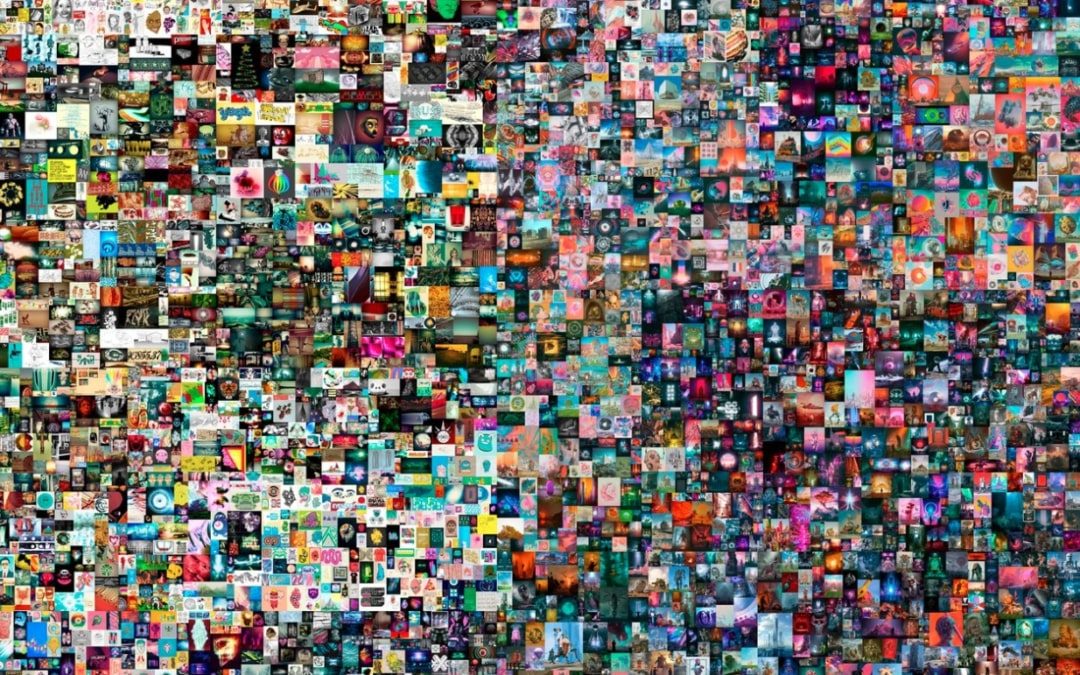The emerging intersection of cryptocurrency and the art world is starting to revolutionize the concept of ownership in today’s digital landscape. It has even resulted in millions worth of sales for artists. Non-fungible tokens (NFTs) allow virtual images and artwork and an original underlying code to be sold as one-of-a-kind artwork, even as copies are made.
The prominence of the NFTs became more evident when a digital art piece by Mike Winkelmann, aka Beeple, sold for a record-breaking $69.3 million during a Christie’s Online auction in March. It became the third most expensive artwork ever sold by a living artist but also the most expensive digital asset ever to be sold as an NFT thus far.
The internet is no stranger to artwork which exists in the form of photo edits, memes and animated GIFs. Digital artwork from drawing to photos abounds and when they’re transformed to binary code, they can populate throughout the internet. Once assigned by a blockchain clearinghouse, NFTs permanently attach to the digital artwork, marking them as official and unique pieces of original artwork. They allow a buyer to own the art, even if other copies already exist on hard drives and servers.
Earlier this year, cryptocurrency NFTs sales became popular throughout the art sector. The ranking site CyrptoSlam reported that the top five NFTs during that quarter amassed more than $366 million in profits. The proliferation had artists and academics alike explore what it means to own something via cryptocurrency.
A London artist and art gallery curator, Marc Craig, sold over 12 original NFTs in less than two weeks. He found the crypto market through online news and noticed the potential to create individual digital artwork marked as exclusive pieces.
As the pandemic changed everything, artists have looked for ways to make money but also connect with an online community through other platforms. The emerging NFT art community has become lively and supportive and many artists are looking to develop NFTs because it’s an easy way to sell and promote their art while connecting with widespread communities. Many have seen artists who both sell and collect NFTs from other creators. Some collectors who sell artwork are now becoming artists themselves.
Some NFT artists are focused on bringing in new artists into the burgeoning NFT art community, offering them encouragement and collaborations. Artist Justin Aversano collaborates with Nicole Buffett through individual and combined work. Their collaborations sold more than 130 pieces of art in two weeks for over $100,000.
For artists like Aversano, one of the most unique ways to sell through the blockchain is the physical artifact outside crypto networks even after the NFT version sells. Both the artist and buyer can negotiate what will happen to the other physical copies. Artists can even include the original copy with the NFT, charge additional fees for the item and sell hardware versions to another buyer or even keep it for themselves. Aversano has retained some original material for some of his more recent NFT wins and hopes to give them to galleries or libraries for display. Physical art copies become an added bonus as buyers now think of ownership in an entirely new way.
But while some collectors don’t want to own physical items, owning an NFT is still not that different from owning a physical piece of art. In many ways, art is an experience. When purchasing NFTs, collectors are buying the knowledge that they are closer to the art, the artist, and their peers. However, those who collect cryptocurrencies often perceive the risk of purchasing such items in a different way.
According to Dr. Carey K. Morewedge of Boston University, those wondering why art buyers spend millions purchasing NFTs for images they could get online for free, she identifies control and ownership as a major theme. Non-fungible tokens simply allow buyers to take possession of the digital as they would otherwise own as physical purchases.
Across the globe, identity is often expressed through the consumerism model. So, when a buyer pays money for an NFT, they can feel they have control over it through their ownership. From a psychological standpoint, the ‘endowment effect’ comes into play — we value what we own over the same thing we don’t own.
Morewedge suggests that the early NFT craze with sales bringing in millions is due to its historical significance. As NFTs are changing the perception of ownership through user-created content. The trend could trigger the start of redesigning how these platforms are monetized, developing new concepts of who owns the material — who owns an item through blockchain and not governmental means.
Despite some of the challenges and costs of some transactions, some artists see the potential for resource management through blockchain. Terra0 is a conceptual framework platform that allows a forest to manage its resources through smart contracts. In this model of self-executed agreements carried out on the blockchain, the forest sold logging permits to generate capital for its maintenance. Similarly, smart contracts have the ability to enhance economic independence for artists in a more sustainable and systemic way. Artists who use NFTs to authenticate their artwork could include codes that automatically pay them royalties each time the token is sold. It would not depend on collectors as the protocol would be cryptographically encoded.
In other ways, smart contracts could offer transparent and secure mechanisms for profit-sharing and making collective decisions that can support organizations like the Artist Pension Trust and W.A.G.E (Working Artists and the Greater Economy), which explore ways to address economic challenges of arts patronage.
Future projects in the NFT world could shift relations within cultural industries. Using code to secure the rights of creators against those of the owners could serve as a step toward rewarding and appreciating the collective process that goes into creating cultural artifacts. This engaging creativity might not be top of mind for collectors now, but the artists who are making these projects are hard at work exploring this fascinating medium.

